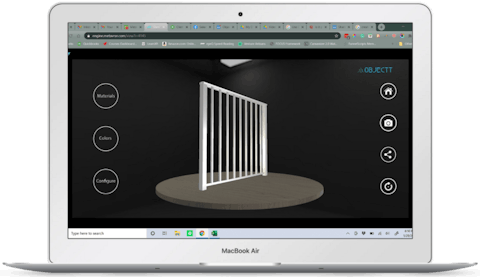More About This Episode
The Smarter Building Materials Marketing podcast helps industry professionals find better ways to grow leads, sales and outperform the competition. It’s designed to give insights on how to create a results-driven digital marketing strategy for companies of any size.
Omar Fagundo is Vice President of RailCo, an aluminum railing company, and Founder of Object.io, an interactive 3D product experience. He talks with Beth and Steve (our Director of Growth) about technology and disruption in the building material space.
The Upcoming 3D Disruption
The building industry is ripe for disruption. Yes, our industry is complex, and that’s a major reason that technology hasn’t easily stood up yet, but that’s also what makes us ripe for disruption. The question is no longer if we’ll be disrupted, but what the biggest opportunity for disruption is.
Omar believes that 3D technologies such as virtual reality and augmented reality are going to disrupt the building construction and materials industries in the next three to five years.
“Any company that could start taking advantage of these technologies is definitely going to have a leg up on their competition because like you said, most people are very comfortable doing everything like they've always done it,” explains Omar. “And those companies that can start experimenting and figure out how can I apply this one solution that's already available on the market to a problem that we've always had, those are the ones that are going to see outsized rewards for their efforts.”
The idea of 3D technology isn’t new to the industry, but there are obstacles that have prevented its widespread adoption so far. One is the current demographics of the industry. But as the old guard starts retiring and being aged out of the industry, many of their old-school business methods are leaving with them.
Millennials, who are much more open to new technology, are quickly becoming the majority of the workforce and entering positions of power. After all, millennials are digital natives and used to constant change.
Plus, there’s a growing business case for adopting 3D technologies and that is saving money. In so many building projects, there are rework orders and oversights and unforeseen issues because no one had a 3D model of the entire project before it started, which would have caught most of those issues.

NERF Technology
These digital natives are going to be more willing to try out technology like augmented reality or even newer technology such as NERFs (neural radiance fields). NERFs allow you to take pictures of any item from a few different points of view, upload them and then get not only a 360-degree view of it but an immersive view. You’re able to look at the item from every single point of view possible. (If you want to try NERF technology, download the app Luma AI.)
What makes NERF technology so exciting is that, normally, in order to create a 360 view of an object, you need at least 27 pictures of it from different angles and each picture has to be uploaded with the exact angle in the exact order or else the click and drag view doesn’t work correctly. With NERF, you only need a handful of images.
“Start experimenting with this because this is the future,” Omar advises. “This is what's going to set people apart in the very near future, especially if you're up on it and you have your finger on the pulse.”
Not All the Old-School Ways Are Dying
Steve talks to hundreds of manufacturers a month, and he agrees fully with Omar that the industry is ripe for disruption.
“I don't think there's ever been a more likely time for that to happen within this industry,” says Steve. “There's so much content, there's so much availability of technology — all of the groundwork is there. And I feel like there has never been a time where a contractor, a GC, an architect, an interior designer, or the homeowner [or] the building owner wants to interact with technology to experience what they're purchasing.”
Steve’s question becomes what old school ways will continue to remain true as the industry begins to adapt to new technologies?
For Omar, it’s strong leadership and an aggressive communication schedule. Technology can help facilitate those things, but the work ethic itself will remain. Plus, all the things technology can’t tap into, such as being analytical, creative and imaginative. Yes, there’s technology that can help you generate ideas (looking at you, ChatGPT). But it won’t take over the aspects of human nature. Instead, we’ll see a “melting and a melding of technology with the things that technology can never really touch, which is the human spirit and imagination and sticktoitiveness.”
Enhancing, Not Replacing, Relationships

The conversation in the industry needs to, and is starting to, shift from “what if technology gets adopted?” to “what do we not have to solve for and how can we expect what we love about our industry to continue?”
As Beth points out, our industry is built on relationships. “An era that I'm excited to see is to have a dominant generation in our industry that views technology as a partnership to relationships, not a risk to relationships and also not just a tool to be leveraged,” says Beth.
As a millennial herself, Beth points out that millennials are a generation that remembers a time before the internet. Most millennials know exactly when they first got dial-up, typically in high school — but even then, they didn’t use it consistently until sometime in college. Millennials have seen the benefits of how being integrated with technology has extended relationships.
“We have friendships that we've created all around the world and continued that would typically not have lasted,” she points out. “They would've just been very seasonal. And [it’s phenomenal] to see a moment in our industry where we can now create technology kind of without barriers but as a partnership.” Beth wants people to see how technology can make what people are already doing more efficient, create greater ROI, decrease prices, increase benefits and build relationships instead of attempting to replace them.
Things can change quickly in our industry. Think about 3D-printed homes. 3D printing has been around since the 1980s, but only 10 years ago someone said, “What if we put cement into the printer instead of plastic?” And now we have 3D-printed homes!
Disrupting the industry doesn’t need to be done only from the outside or from the inside, but with a hybrid approach. For instance, what would happen if you mixed 3D-printed homes with generative AI technology and augmented reality offsite manufacturing processes? How affordable could that home be while still maintaining all the relationships?
Technology and New Workers
Integrating software and technology will only get us so far, however. As Steve points out, seeing how a faucet looks in your kitchen with augmented reality is great, but if I can’t buy it effectively, what’s the point? We need to integrate all of these technologies to design, see, build, buy and install products.
Omar agrees: “Overall, if you look at this conversation, it's not so much new technologies but new workflows. How do you take A plus B plus C plus D to get Z?”
“Millennials have the largest buying power of any generation right now. However, like I said, a lot of us remember when life was analog. So we have an acceptance of lack of technology. We don't love it. We don't ever want to talk to a human,” Beth laughs. But millennials are not the young generation anymore.
As Gen X and baby boomers age out of leadership positions and older millennials move into them, we have to realize that the same shift is happening from a consumer standpoint. And we can’t ignore Gen Z. They’re graduating from college now. They’re going into the workforce and starting to become a large segment of consumers.
“I was at a presentation for our local NAHB chapter, and they're projecting the need for an additional 61,000 people in the industry every month,” says Beth. “They need a total of 2 million people over the next five years added to our industry — Gen Z is not coming into an antiquated industry. They're not going to adopt an antiquated career. And you could overcome stigma for Gen Z from a blue-collar perspective a lot faster than you can overcome their absolute disdain for analog life.”
This leaves the door wide open for disruption. Startups will have the opportunity to be the Netflix of the building industry because they can be nimble, optimizing and innovating while the big established companies are too afraid to change.
The huge deficit in trade workers means we need technology. It’s not only going to help us build more efficiently and build more efficient buildings, but it’s also a way to attract new workers to the industry.
What Technologies Do New Workers Need to Know?
A lot of what people need to know can be overcome through training. In many trades, training is overlooked. They give you OSHA training and then send you out in the field to learn as you go.
“I think we have to do a better job as an industry overall to train and to promote because everyone wants to feel like they're part of something special and they want to feel like there's upward mobility,” explains Omar. “So it's not so much what technology you already know but what technology can you learn while you're employed at a trades company and a building materials company. How can you level up and get to the next place? Because nobody just wants to stay in that entry-level position forever. That's exactly why nobody wants to work in the trades.”
The problem that needs to be solved is not only how we attract people to these jobs but once you get them in, how do you make them feel they can win and grow without having to start their own business?
Disrupting Your Own Company
Omar constantly says that he’s trying to disrupt his own company. What does that look like?
“It's a simple process. You take a look around at a broken process … that you don't like to do but you have to do all the time and you figure out a way to improve it through things that are already available.”
The good news is that every day, there are more solutions available that you can use to solve your problems. In fact, some are free online if you take your time and do your research.
When Omar first started at his father’s company, he realized his dad was still doing payroll by hand: “Every other Friday, he would basically lock himself up in his office with a calculator and calculate out everyone's payroll and hand write checks.” Omar immediately knew that was a disruption ripe for the picking.
Omar advises people to look at what is taking them too much time to do or what is taking the principals in their company too much time to do — time away from what they should be doing. Look for tasks that take people away from the aspirational, more vision-oriented tasks and find ways to disrupt those.
For example, at Railco, Omar was having to hand calculate the cost of custom railing configurations. He knew there had to be a better way. So he did his research and found Grasshopper, a parametric design software, which helped him easily calculate a costing model for any project.
Want Even More Insight?
If you want to succeed, disrupt your own company. Start by solving problems you already have with solutions that are already available.
To learn more about this topic, listen to the entire episode here. You can reach out to Omar on LinkedIn.
Remember to like and subscribe to Smarter Building Materials Marketing wherever you get your podcasts.








